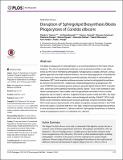Disruption of Sphingolipid Biosynthesis Blocks Phagocytosis of Candida albicans
Author(s)
Tafesse, Fikadu G.; Rashidfarrokhi, Ali; Freinkman, Elizaveta; Dougan, Stephanie; Dougan, Michael; Esteban, Alexandre; Maruyama, Takeshi; Strijbis, Karin; Schmidt, Florian Ingo; Ploegh, Hidde; ... Show more Show less
DownloadPloegh_Disruption of.pdf (8.001Mb)
PUBLISHER_POLICY
Publisher Policy
Article is made available in accordance with the publisher's policy and may be subject to US copyright law. Please refer to the publisher's site for terms of use.
Terms of use
Metadata
Show full item recordAbstract
The ability of phagocytes to clear pathogens is an essential attribute of the innate immune response. The role of signaling lipid molecules such as phosphoinositides is well established, but the role of membrane sphingolipids in phagocytosis is largely unknown. Using a genetic approach and small molecule inhibitors, we show that phagocytosis of Candida albicans requires an intact sphingolipid biosynthetic pathway. Blockade of serine-palmitoyltransferase (SPT) and ceramide synthase-enzymes involved in sphingolipid biosynthesis- by myriocin and fumonisin B1, respectively, impaired phagocytosis by phagocytes. We used CRISPR/Cas9-mediated genome editing to generate Sptlc2-deficient DC2.4 dendritic cells, which lack serine palmitoyl transferase activity. Sptlc2[superscript -/-] DC2.4 cells exhibited a stark defect in phagocytosis, were unable to bind fungal particles and failed to form a normal phagocytic cup to engulf C. albicans. Supplementing the growth media with GM1, the major ganglioside present at the cell surface, restored phagocytic activity of Sptlc2[superscript -/-] DC2.4 cells. While overall membrane trafficking and endocytic pathways remained functional, Sptlc2[superscript -/-] DC2.4 cells express reduced levels of the pattern recognition receptors Dectin-1 and TLR2 at the cell surface. Consistent with the in vitro data, compromised sphingolipid biosynthesis in mice sensitizes the animal to C. albicans infection. Sphingolipid biosynthesis is therefore critical for phagocytosis and in vivo clearance of C. albicans.
Date issued
2015-10Department
Massachusetts Institute of Technology. Department of Biology; Whitehead Institute for Biomedical ResearchJournal
PLOS Pathogens
Publisher
Public Library of Science
Citation
Tafesse, Fikadu G., Ali Rashidfarrokhi, Florian I. Schmidt, Elizaveta Freinkman, Stephanie Dougan, Michael Dougan, Alexandre Esteban, Takeshi Maruyama, Karin Strijbis, and Hidde L. Ploegh. “Disruption of Sphingolipid Biosynthesis Blocks Phagocytosis of Candida Albicans.” Edited by Alex Andrianopoulos. PLOS Pathogens 11, no. 10 (October 2, 2015): e1005188.
Version: Final published version
ISSN
1553-7374
1553-7366